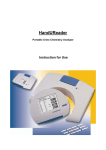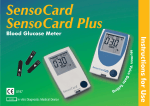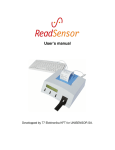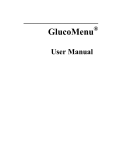Transcript
CH CHOLESTEROL ENG Reagent strips for the determination of Total Cholesterol concentration To be used only with the 3in1. Instructions for use Introduction With the 3in1. Cholesterol strips it is possible to quickly check cholesterol levels in the blood and inform the family physician to find a suitable therapy or to check-up on an existing therapy. The level of cholesterol in the blood is influenced by the diet, but also by: medicines, diabetes mellitus, pregnancy and severe illnesses. It is recommended to check blood cholesterol concentration on all people who are used to smoke, to drink too much alcohol and to eat fat and are over weighted or do not exercise enough. It is specially recommended to people who already had heart disease or with familial cases of heart diseases before the age of 60. Perform the test at fast for at least 9 hours. Test principle The test is based on a Cholesterol/Esterase Oxidase/Peroxidase/Chromogen reaction. The intensity the colour developed from the reaction is proportional to the concentration of Total cholesterol in the blood Composition The reactive area of each strip contains: chromogen min. 0,025 mg; Cholesterol Esterase: 0,8 IU Procedure •Open the pack of 3in1. Cholesterol strips, pull out the data-chip of green color. •Insert the data-chip into the proper space on the side of the meter (picture 1). •Open the vial, take a strip and immediately close it. •Insert the strip in the strip holder of the meter (picture 2), with the coloured side visible till to hear an acoustic signal (“bip”) •Check that CH symbol appears on the display and check that the number on the strip vial label is the same of the one on the display (picture 3). •wash the hand with hot water and massage the finger that you choose for the pricking to increase the blood flow. Let your arm hang down for about one minute •execute the puncture of the finger using the lancing device and a sterile lancet. •remove the first drop with a sterile gauze and gently press the finger to obtain a second drop (10 microliters) •approach the pricked finger with the drop of blood to the lower part of the strip (picture 4), it is the part that come out of the instrument. The sample of blood will be automatically aspirated by the strip. Do not remove the finger until the moving segments will appear on the display (the instrument will emit an acoustic signal “bip”). •Some seconds the result will be displayed •Use the ejector key on the backside of the meter to remove the used strips in order to avoid contaminations. Only one measurement has to be carried out for each finger pricking! Carefully follow the instructions contained in the user manual. All components of the pack has to be disposed properly, avoiding contaminations. Correct test execution check After each measurement, check the circular opening under the reactive area in correspondence to the opposite surface where the blood sample has been applied, the colour must be uniform. If not, repeat the measurement. Testing the system A check-up of the user’s skill, the correct working of the 3in1. instrument and its strips, must be periodically carried out through the use of the 3in1. Cholesterol Control Solutions and by following the included instructions. The expected results for this test are printed on the vial’s label of the 3in1. Cholesterol strips that are being used. Storage and expiry date Keep the reactive strips at temperatures between 5°C (41°F) and 30°C (86°F) and keep them in the original vial. Do not expose to direct sun light. Close the vial with the original cap immediately after pull out the strip. In this way, the strips will last up to 3 months after the first opening. The expiry date on the package of strips refers to a new unopened vial. The use of expired strips can cause wrong results. Do not expose to excessive humidity. Do not freeze! Table of results Cholesterol below 130 mg/dL (3,3 mmol/L) = LO* Cholesterol between 130 mg/dL (3,3 mmol/L) and 400 mg/dL (10,2 mmol/L) = the numerical result Cholesterol above 400 mg/dL (10,2 mmol/L) the display = HI** *Repeat the test. **Such results mean that the Cholesterol concentration in the sample is very elevated and it indicates a serious risk. Contact a phisycian immediately. Cholesterol values Less than 200 mg/dL (5,1 mmol/L) = desirable values From 200 mg/dL (5,1 mmol/L) to 239 mg/dL (6,1 mmol/L) = high risk factor More than or equal to 240 mg/dL (6,1 mmol/L) = high cholesterol The analytical results have to be communicated to the physician. The self-checking can be useful for the physician in order to formulate a diagnosis. Warnings •Long exposure to air and light can alter the results. It is recommended to keep the strips in the original vial with the cap at room temperature between 5 and 30°C (41 and 86°F). •Avoid exposing to excessive humidity, do not freeze! •Keep the 3in1. Cholesterol strips away from children. •Do not perform any tests bellow 10° C (50°F) or above 40°C (104°F). •Do not touch reacting strips with polluting agents, like for example dirty hands, the results could be seriously altered. •Use the strip immediately after removing it from the vial. •Make sure the vial is properly closed after removing the strip and use its original cap containing drying material. Do not place the strips in a different container. •The 3in1. Cholesterol strips must be used within and not after the expiry date on the package. Once the vial has been opened, use the strips within 3 months. The reactive area on the strip is white in optimal conditions. Do not use the strip if the reactive area has a different colour. Notes for doctors and labs To measure the Cholesterol with the 3in1. system it is possible to use fresh capillary blood. Do not use serum or plasma on the strip. Limitations •If the value of cholesterol after testing does not correspond to the normal sensations felt by the patient and to the basic knowledge of health conditions and symptoms, repeat the test. Read the user manual to verify the correct determination procedure and consult your physician. •Recent illness, pregnancy and hormonal contraceptives may influence the cholesterol values. Results obtained under such conditions must be referred to the physician before any dietetic or therapeutic measures are applied. •Should the values of cholesterol be over 240 mg/dL (6,1 mmol/L), contact a physician immediately. •Reducing agents like for example, Ascorbic acid, at normal concentrations, do not interfere. If high quantities are taken, low cholesterol values could be obtained. •The result is affected by high levels of steroids, triglycerides and bilirubin. •Inaccurate results can be obtained at high altitudes since the concentration of oxygen is lower. •Abnormal values of hematocrit (higher than 50% or lower than 35%) can influence the results. •Minimum volume of blood sample: 10 μL. Accuracy The average error of the 3in1. system compared to the reference method CHOD-PAP is <10%. In a series of measurements performed in a hospital, the following linear regression has been obtained y=0,9599 x-5,4277. Precision Repeatability: the average inaccuracy is <5%, in a series of measurements performed in laboratory an average coefficient of variation of 2,14% was obtained. Reproducibility: The average inaccuracy is <5%, in a series of measurements performed in laboratory an average coefficient of variation of 3,95% was obtained. CE mark Use until ... Control Solutions In Vitro Diagnosticum Batch number Level 1 Store at ... Follow instructions Level 2 VPD Bled d.o.o. Pot na Lisice 4, 4260 Bled, Slovenia tel: ++386 4 574 50 70 fax: ++386 4 574 50 71 In vitro diagnostika IN TGL ED2009 REV01-E-SL








